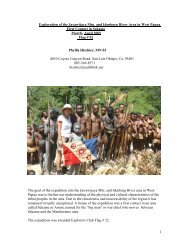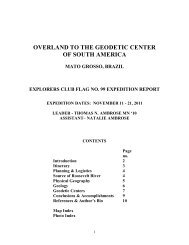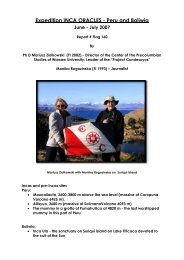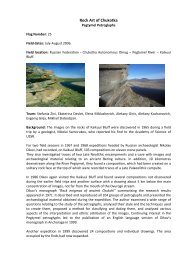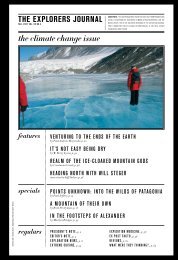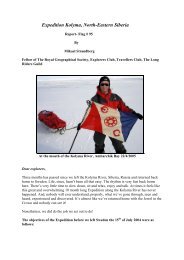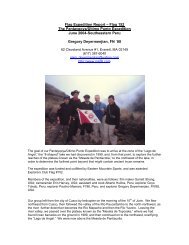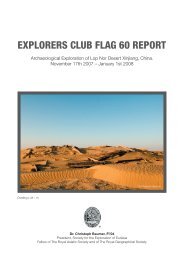the explorers journal the global adventure issue - The Explorers Club
the explorers journal the global adventure issue - The Explorers Club
the explorers journal the global adventure issue - The Explorers Club
- No tags were found...
Create successful ePaper yourself
Turn your PDF publications into a flip-book with our unique Google optimized e-Paper software.
fiction than a factual account. During our trip,we had an opportunity to visit Fort Conger andsee <strong>the</strong> remains of Greely’s camp—<strong>the</strong> artifactswell preserved in <strong>the</strong> cold dry climate. It was<strong>the</strong>n that I realized I wanted to bring this importantepisode in <strong>the</strong> history of Arctic explorationto <strong>the</strong> public’s attention in a documentary film.In <strong>the</strong> summer of 2000, I joined a kayak triporganized by Steven Smith, a professionalguide, outfitter, and field biologist, to kayakfrom Alexander Fiord to Pim Island to see <strong>the</strong>site of Greely’s winter camp near Cape Sabine.When I first asked Steve whe<strong>the</strong>r it would befeasible to retrace Greely’s retreat from FortConger to Cape Sabine with a documentarycrew using inflatable boats, he dismissed <strong>the</strong>idea as being impractical and extremely hazardous.But, after fur<strong>the</strong>r consideration, hethought it possible if he could assemble an expertcrew using kayaks, which could be moreeasily hauled over <strong>the</strong> ice.While doing historical research for <strong>the</strong> project,I was fortunate to meet many of Greely’sdescendants, all of whom were very enthusiasticabout <strong>the</strong>ir ancestor, “<strong>The</strong> General.”Greely’s great-grandson, David Shedd ofBartlett, New Hampshire, suggested that hisson James, <strong>the</strong>n a senior in college, participatein <strong>the</strong> expedition as a representative of <strong>the</strong> family.<strong>The</strong> organizing structure of <strong>the</strong> film quicklyfell into place: we would not simply present <strong>the</strong>historical material, but ra<strong>the</strong>r, actively engage<strong>the</strong> viewer in <strong>the</strong> drama by telling Greely’s storythrough <strong>the</strong> eyes of his great-great-grandson,James Shedd. At <strong>the</strong> same time we would put<strong>the</strong> viewer in touch with <strong>the</strong> spectacular environmentas James retraced <strong>the</strong> party’s arduousjourney down <strong>the</strong> coast of Ellesmere.But James’ ability to participate was by nomeans certain: <strong>the</strong> expedition would be a challengeto <strong>the</strong> most experienced guide and hisexperience as an outdoorsman was limited tocamping in <strong>the</strong> White Mountains with his fa<strong>the</strong>rand skiing. To his credit, James enthusiasticallyundertook preparing himself for <strong>the</strong> challengeby kayaking in <strong>the</strong> Pacific Northwest and undertakinga very strenuous backpacking trip in <strong>the</strong>High Arctic. Ultimately, Steve agreed to takehim on and subsequent events would provethat James more than met <strong>the</strong> challenge.In many ways <strong>the</strong> success of both <strong>the</strong> filmand expedition depended on logistics andcareful organization. Fortunately, <strong>the</strong> projecthad engaged <strong>the</strong> services of two seasonedprofessionals: Steve Smith and Gino DelGuercio of Boston Science Communications.Gino has created award-winning documentariesfor PBS, NOVA, and <strong>the</strong> DiscoveryChannel. While he was an avid outdoorsman,he had never been to <strong>the</strong> Arctic. O<strong>the</strong>r expeditionmembers included professional guideswho had worked with Steve for many years.<strong>The</strong> most difficult step would be arranging<strong>the</strong> transport of <strong>the</strong> team and its equipment toFort Conger, as well as <strong>the</strong> teams subsequentresupply en route. Fuel for <strong>the</strong> Twin Otters and<strong>the</strong> helicopters used for aerial photographywould need to be cached along <strong>the</strong> coast andthat in itself would require expensive transportationand additional fuel.<strong>The</strong> expedition component of <strong>the</strong> documentary—afive-man, one-woman team using threekayaks—would retrace Greely’s journey down<strong>the</strong> coast from Fort Conger to his winter campat Cape Sabine. Since <strong>the</strong> kayaks could notcarry sufficient food and supplies for <strong>the</strong> anticipatedsix- to seven-week expedition, Gino,Tom Stere, and I would serve as <strong>the</strong> supportteam: leapfrogging down <strong>the</strong> coast by planeto resupply <strong>the</strong> team, filming from shore andhelicopter, as well as providing a communicationslink. We would be aided by Scott Simper,a professional <strong>adventure</strong>r videographer, whowas one of <strong>the</strong> kayakers. <strong>The</strong> kayak team alsohad a small video camera that it would use torecord <strong>the</strong> members’ private thoughts during<strong>the</strong> trip. Gino had arranged for ano<strong>the</strong>r cameraman,Simon Reeves, to do filming when <strong>the</strong>team arrived at Cape Sabine.While <strong>the</strong> route and <strong>the</strong> environment wouldbe much <strong>the</strong> same as Greely encountered,<strong>the</strong>re were many important differences: wewould be using <strong>the</strong> very latest in outdoorequipment, and we had access to communicationsvia satellite-phone and high frequencyradio between team members, <strong>the</strong> supportcrew, and <strong>the</strong> outside world. Perhaps <strong>the</strong> mostimportant difference was <strong>the</strong> time of year:<strong>the</strong> <strong>explorers</strong> <strong>journal</strong>



